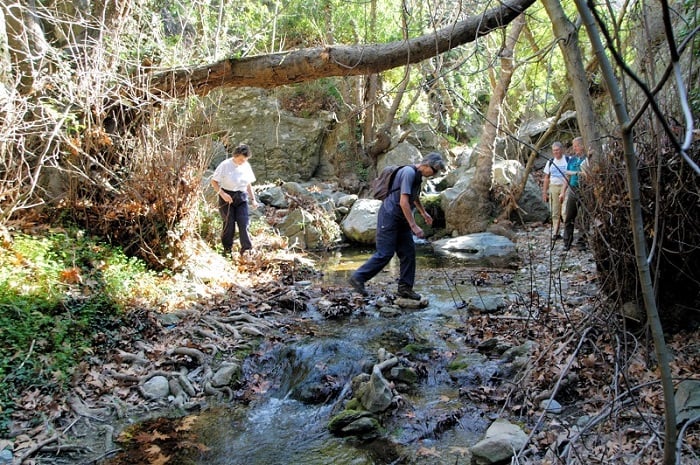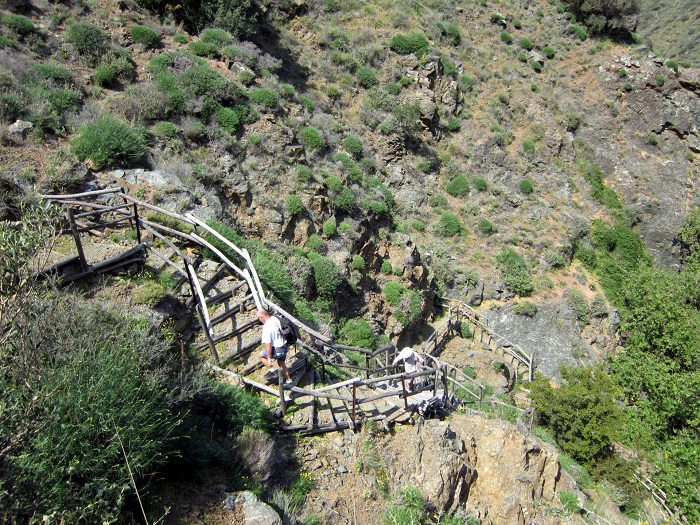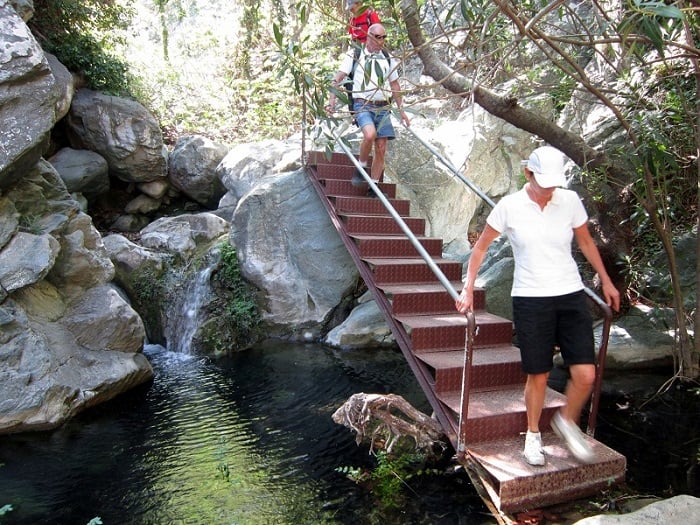
The Richtis Gorge in eastern Crete may not be as well known as the Samaria Gorge, but it is a lush paradise. Hiking in the gorge is done in the shade of trees with a stream flowing in it, even during the summer months. It’s a very special place for hiking.
By Tony Cross
If you use the words ‘Crete’ and ‘gorge’ in the same sentence everyone will assume you’re talking about Samaria. Although the Samaria Gorge is the best known gorge on Crete, it’s far from being the only one.
Crete is sometimes called the ‘king of gorges’ and with good reason; there are over 400 gorges on the island. Some are large and impressive, others are small and intimate, almost all are accessible to the keen hiker.
Summer can be a risky time to go gorge walking on Crete however, once the summer sun penetrates into the bottom of a gorge the temperature rises rapidly.
The Richtis Gorge, close to the village of Exo Mouliana in eastern Crete, is an exception. It has a small stream flowing in it, even during the summer months. Consequently the gorge is lush and wooded and most of the walking is done in the shade of trees.
By far the best time to walk the gorge is in early spring when the winter rains have swelled the stream and there is dense undergrowth and a great many flowers in bloom. In the height of summer the trees still provide ample shade but the undergrowth is greatly thinned out and the stream is small and frequently disappears underground.

The walk begins at the Lachanas bridge, a lovely stone-built bridge dating from near the end of the 19th century. It once carried the main road from Agios Nikolaos to Sitia and in the early years of the 20th century was the location of a terrible tragedy.
Following the defeat of the Ottoman Empire at the end of WWI there were so many ethnic cleansing events in both Greece and Turkey, as communities took out their frustrations on each other, that the Great Powers ordered a population swap. All ethnic Greeks in Turkey and all ethnic Turks in Greece were forced to relocate to their respective country of ethnicity.
The story goes that a group of about 60 ethnic Turks were walking towards Sitia to catch a ship that would take them to Turkey. As they crossed the Lachanas bridge some local Greeks trapped them on the bridge and slaughtered them.
The people who live in the area today vehemently deny that this massacre ever took place but at the time it was sadly not unusual and was the very reason why the population swap had been ordered in the first place.

Early part of Richtis Gorge “a delight”
You start the walk by following the path under the bridge, there are signposts all down the gorge, though they are easily missed if you’re not paying attention. One unfortunate feature of this gorge is that there are many false trails and it’s very easy to get lost if you miss a signpost and take a wrong turning.
The early part of the gorge is an absolute delight. The path winds through woodland alongside the stream. Although you’re always descending it’s very easy walking here – except for the many tree roots which will trip you if you lose concentration.
The path crosses and re-crosses the shallow stream may times. In the summer it will be an easy hop across, in the winter you’ll need to use handy logs and stepping-stones.
About twenty minutes in to the gorge you’ll come across the ruins of a plunge mill. These are a type of water mill that were perfectly suited to the small and rocky streams that are common on Crete. They work by tapping the stream much further up and bringing the water down a gently-sloping man-made channel to a pond about fifteen metres above the mill and the stream.

A gate in the pond allows water to plunge down a tower, at the bottom the energy of the falling water turns a mill wheel. The waste water flows out of the mill and back into the stream, where it can be re-used by other mills further down.
In this particular mill the tower is clearly visible, covered now by moss and creepers. Inside the ruins of the building below it you’ll find one of the millstones still in position. The wooden mill wheel and mechanism are long gone of course but it’s easy to see how the mill would have operated.
Shortly after this first mill the path becomes more rocky. It’s still under the shade of trees but now you’ll find several sections where some rock scrambling is required. Balance, agility and sure-footedness are needed for many of these sections. In several places where rock scrambling would be particularly difficult there are metal stairs bolted securely to the rock.

Eventually you’ll arrive at the top of a wooden stairway that zig-zags its way down the side of the gorge. The dramatic change in height here is because this is the site of a waterfall. You won’t be able to see it until you reach the bottom however.
Hiking to the highest waterfall in Lasithi province
At twenty metres high this is the highest waterfall in Lasithi province. In the summer there is often only a small trickle coming over and people swim in the pool at the bottom. In the winter it can be quite impressive.

From the waterfall to the beach it’s mostly fairly level walking, still generally alongside the stream. A few minutes before the beach you’ll walk out of the shade of the trees and into the open air and sunshine. In the summer you’ll definitely need a hat on this section.
At the beach you’ll find concrete picnic tables set up in the shade of a grove of tamarisk trees. There is a fresh water tap here from which you can fill your water bottles for the trip back up. The beach itself is a disappointment. It’s covered in large stones and it’s very difficult to get in and out of the sea for swimming. It’s not an especially pleasant beach for sunbathing either.
Just before the beach you’ll have passed a car park and a road that zig-zags its way back up to Exo Mouliana. If you have a friendly driver who can meet you here you can avoid the walk back up the gorge. I recommend walking back up however, it’s a different experience walking up and you’ll see things that you missed on the way down.
I’ve walked a number of the gorges on Crete, including Samaria, and I keep coming back to Richtis. It’s a very special place.
See all the latest news from Greece and the world at Greekreporter.com. Contact our newsroom to report an update or send your story, photos and videos. Follow GR on Google News and subscribe here to our daily email!



